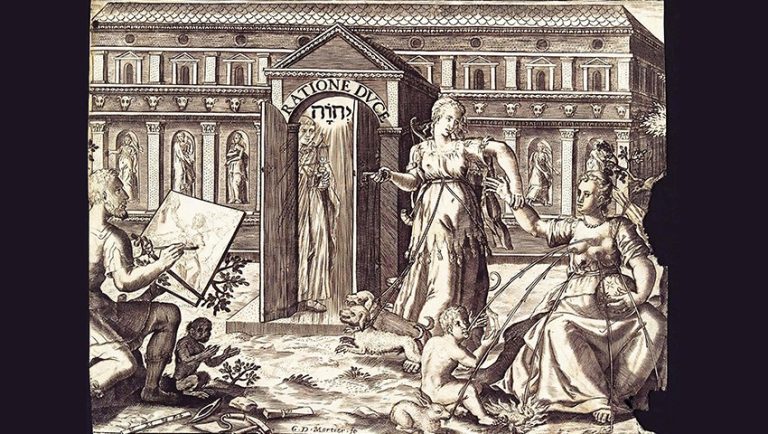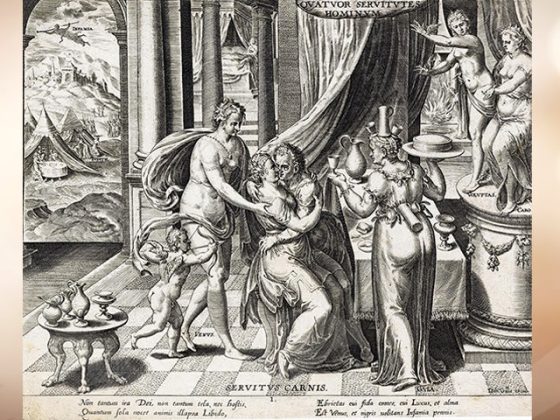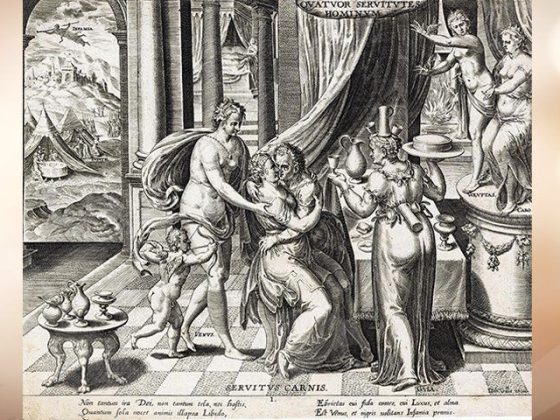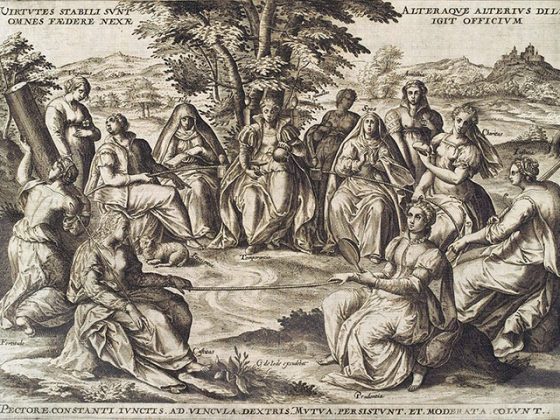Highly appreciated friends:
It is with great pleasure that I transmit to you this engraving, which belongs to the Herzog August Library, Germany. Such an engraving was created between the years 1551 and 1600, and the engraver, according to the library catalogue, would be named G. D. Montier. This engraving has no title, so we have titled it as follows:
WITH REASON AS A GUIDE
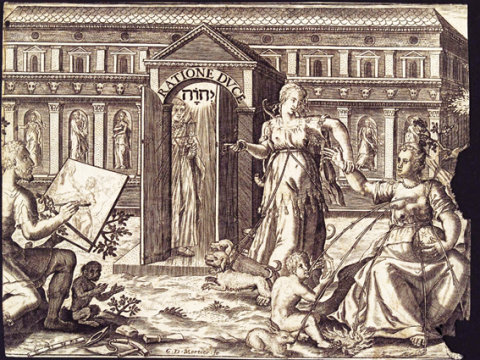
Biblioteca Herzog August, Germany
Our illustration shows us, first of all, two female representations. One appears full of breasts from which abundant milk gushes out that feeds various creatures such as a monkey, two puppies, a bird, a rabbit and a salamander, as well as a child. This lady that we are commenting on is sitting and her right arm is stretched out and held by another lady who is standing up.
In front of her, and with a building in the background whose door has the Hebrew letters IOD, HE, VAU, HE, we see a painter trying to reproduce the seated lady on a canvas. What is all this? Let us see:
The seated woman who gives her milk to various creatures is none other than Divine Mother Nature. By means of Gnosis we have learned that the Divine Eternal Feminine has five aspects, namely:
- Cosmic Mother ─Nut among the ancient Egyptians─.
- Mother Nature –the Mother Nature who contains the mineral, plant, animal and human kingdoms–.
- Mother Kundalini –the particular Stella Maris, our inner Sacred Fire, the intimate Ram-IO in each one of us–.
- Elemental Mage –the mother of all our instincts–.
- Mother Death –Hekate, Proserpina, Mictlancihuatl of the Aztecs–.
Certainly, Mother Nature nourishes everything created with her divine energy: oceans, mountains, air, oxygen, fire, volcanoes, mines, animals —huge and tiny— and us, humans, as part of her children.
It is this depiction that the artist who is seated contemplating the rest of the engraving itself is trying to paint. Human beings have always been attracted by the greatness of Divine Mother Nature. However, in our days, when humanity has an asleep Consciousness, it does not even realize the greatness of creation, the magnificence of its fruits, and the immense variety that it has been able to show us. That is part of our world tragedy.
Let us observe that this Mother Nature has on her womb a sphere that represents our world, our planet, for she is indeed our mother.
Now then, why does she stretch out her arm and offer her hand to the other lady, who in turn holds in her other hand a key with which she opens a door behind which an Adept carries a lamp? Why does the building to which the lady invites Mother Nature to enter have the inscription RATIONE DVCE, and, furthermore, underneath those words are the Hebrew letters?
Here it is important to comment on certain aspects about which Samaelian Gnosis has already warned us many times. For example, the lady who takes the hand of the woman who represents Mother Nature and invites her to enter that building is none other than the Cosmic Mother, the lady ruling the universes, the galaxies, the solar systems. Certainly, she holds the keys, the power to bring life into the Cosmos or to return it to its origins. And what are its origins? Well, Gnostic Kabbalah explains to us very clearly that beyond the multidimensional space lies the unknowable, the immutable. That, in Hebrew terms, would be IOD-HE-VAU-HE, which translated into English would be IOD-HEVE or JEHOVAH. IOD-HE-VAU-HE comes to be God in abscondito, the unmanifested God, etc., etc., etc.
There is no doubt that the Adept who appears with a lamp inside the building is none other than an Elohim, a certain divine manifestation. The Elohim serve the immaculate womb of the Universe.
Behind the lady representing the Mother of the Universe seems to be another dog or puppy. We do not comment on it because we do not see it in an attitude of acting in this or that way.
What is important to emphasize now are the two Latin words that say RATIONE DVCE, and which, translated into English, express ‘by ways of reason’. For us to one day enter the realm of Absolute Abstract Space we will need a superior logical thinking, a product of the inner mind and not of intellectual rationalism. This superior logic ─V.M. Samael Aun Weor tells us─ does not belong to the battle of antitheses or to formal logic, it is the fruit of the Illuminating Void, it belongs to the objective reason of the BEING.
On one occasion, the great philosopher Seneca, referring to intellectual reason, exclaimed: “Hac ratione duce per totam vitam eundum est, minima maxima que es huius consilio gerenda.”
Translation: ‘Having reason as a guide, one must advance all one’s life, the maximum or minimum things have to be managed by means of its advice’.
Following our description, let us now look at the instruments that are on the ground near the painter or artist. There we can see a hammer, a chisel, a trowel, a ruler –used for measuring– and an oil lamp of the kind used in ancient Rome. Why is this there?
These are Masonic instruments that symbolize the tools to create within us the castle of Camelot. The hammer symbolizes the human will, the chisel represents intelligence, the trowel represents the three primary forces of creation, the ruler allegorizes the rules we must respect when working in the transmutatory ars, and the oil lamp points to the need to light our fires to illuminate us on the path.
Let us conclude by saying to all of you, dear readers, that EVERYTHING COMES OUT OF THE HOUSE OF GOD AND RETURNS TO THE HOUSE OF GOD.
Oremus…
I now give you a few sentences that deserve to be reflected upon:
“Human reason is a drop of light in a lake of darkness.”
Commerson
“Reason is like the wind, it blows out a torch and stokes a fire.”
Ugo F. Osculo
“Reason can withstand disasters, error cannot.”
Rabindranath Tagore
“Reason is the light and ornament of life.”
Cicero
“There is no good thing that does not have its basis in reason.”
Seneca
PACTA SUNT SERVANDA.
─‘Agreements must be kept’─.
Kwen Khan Khu


